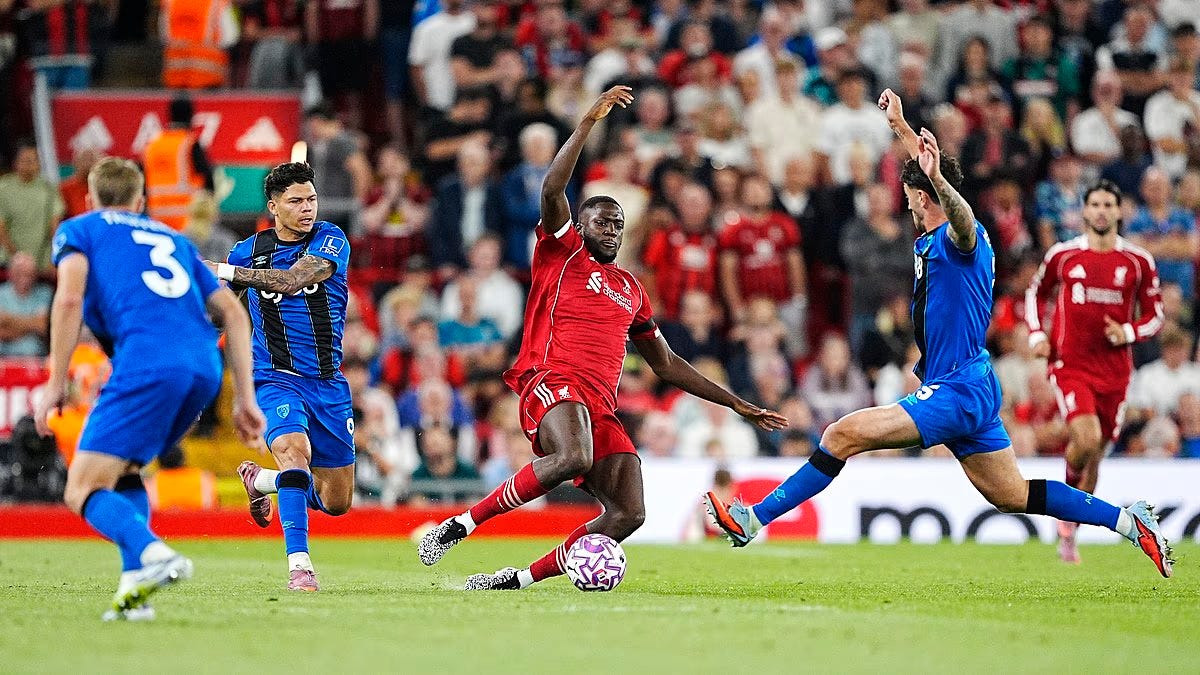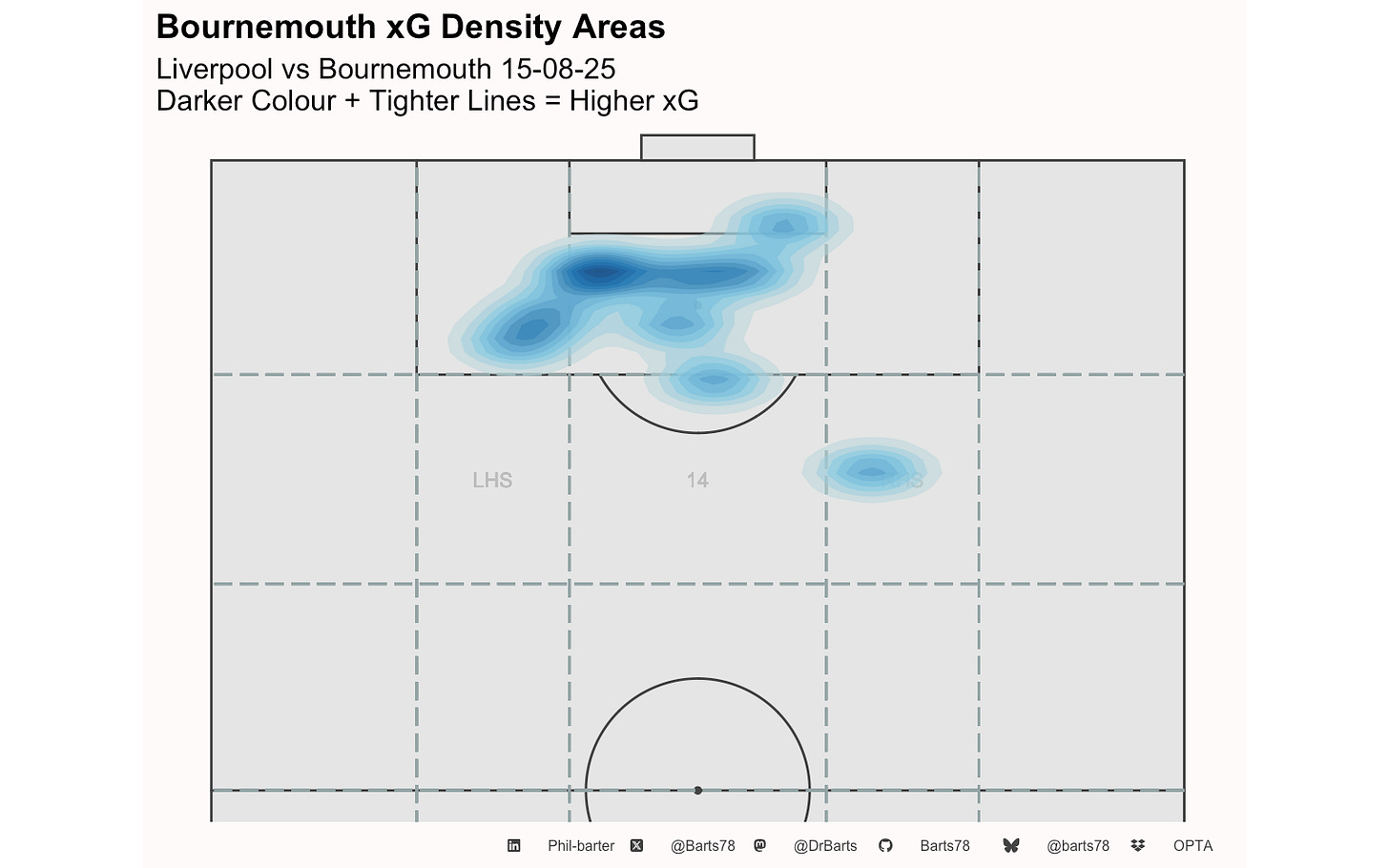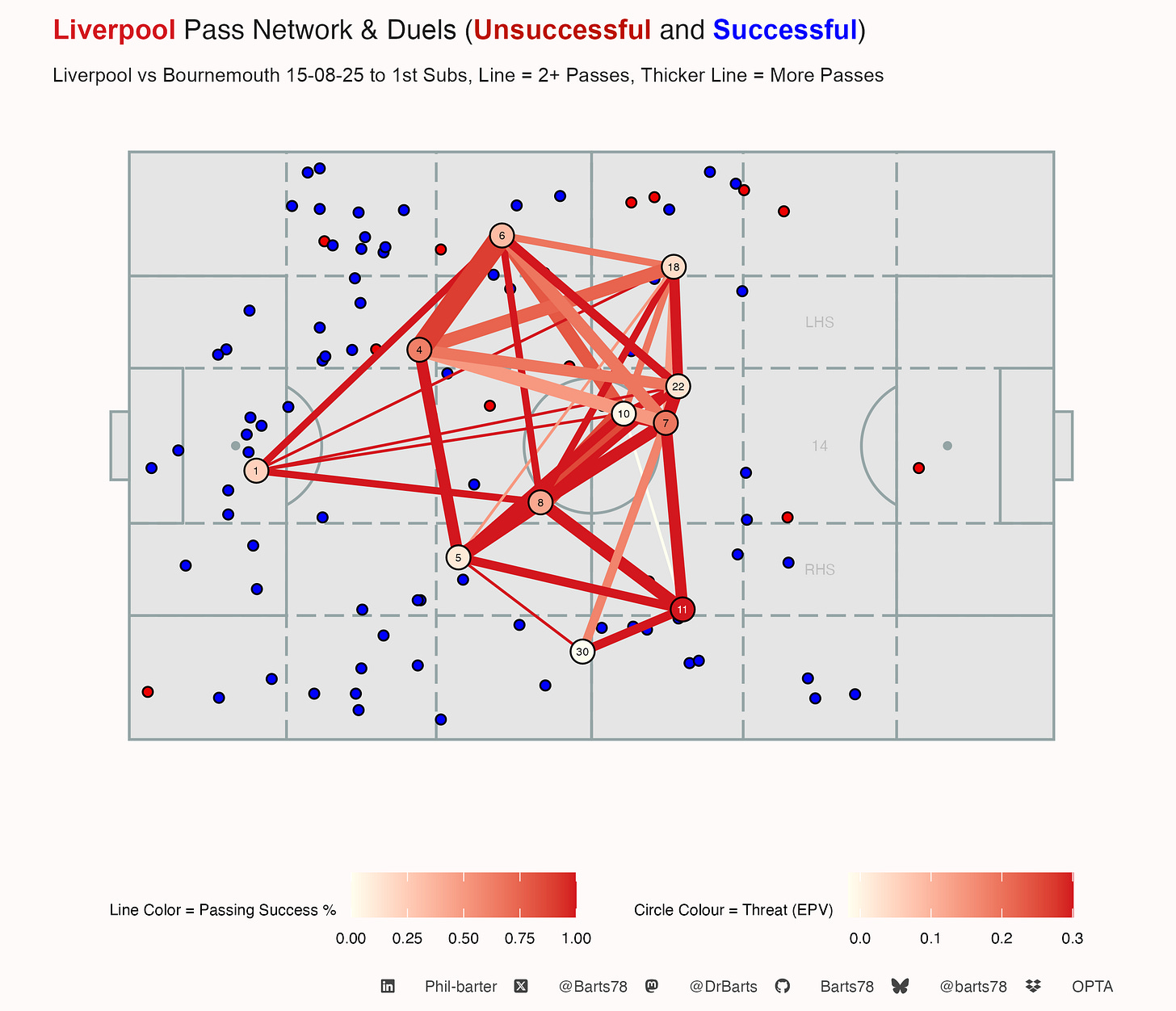Analysis: Liverpool's Defensive Structure Must Improve Fast
Context Matters But The Problems Are Real
I need to say this right at the start. I’m a bit more pragmatic when reviewing Liverpool’s 4-2 win over Bournemouth last Friday night, I’m neither positive or negative.
Of course, there were great moments. Federico Chiesa’s brilliance lit up Anfield, and Mohamed Salah once again proved to be inevitable on the opening day. But as ever, this Substack has never really been about results. It’s about process, repeatability and what the performance tells us about what comes next.
That’s why I’m focusing on the defensive trends that we saw in pre season surface at Anfield. Liverpool conceded two goals from counter-attacks in one match. For context, they conceded just one from a counter all last season across 38 league matches. Our on ball shape as shown by the below zone map, was similar to last season, aside from both full back took up wider positions, to match the wide forwards, but the players covered the centre of the pitch well, although we could have had more depth to our play and covered zone 14 more.
Some of this might be circumstantial, Arne Slot had a number of things forced on him before and during the game. Jeremie Frimpong had to start at right-back because Conor Bradley was injured. Ryan Gravenberch was suspended following his red card against Crystal Palace on the final day of the 2024-25 season. Slot didn’t want to be without both Gravenberch and Mac Allister, so he started the latter despite him being unfit to play the full match.
He said before the game: “Macca is back, which is nice. He will not be available for 90 minutes, unfortunately, because he missed quite a long period of time. But he’s back now with the team for two to three weeks, so we think he’s able to start again. Even more because we miss Ryan Gravenberch as well and last season we mainly played with him, Mac Allister and Dominik Szoboszlai. If you have to miss two in the first game of the season, that would not be ideal. That’s why I decided to start Mac Allister.”
In attack, Hugo Ekitiké had to play because there is no other senior centre-forward. After Frimpong picked up a hamstring injury during the match, Wataru Endo came on and played at right-back as Joe Gomez had missed most of pre-season and was not ready to play more than 20 minutes. This isn’t ideal, and it is worth recognising that context.
However context should not be a shield for everything. This is not about a bad performance from a couple of individuals. It is about a broader issue with the structure, particularly in transitions. Our off ball shape looked very different from last season, in this game as the below map shows, the zones in the centre of the pitch are small and the structure is not ideally setup to prevent counter attacks.
Patterns From Pre-Season Are Carrying Over
If you’ve been reading this Substack through pre-season, none of this should have surprised you. Liverpool were poor without the ball in most matches. AC Milan thrived on the break. Crystal Palace exposed space, and now Bournemouth have done the same. It’s becoming a pattern, and patterns matter more than moments.
Liverpool conceded 10 shots worth 1.7 expected goals in this game. Last season, they gave up more than that in only 5 league matches. Four of those came after the title was already won. So this is already near the worst end of the spectrum. Bournemouth created 3 big chances at Anfield. That simply should not be happening. Looking at the density plot below, it indicates how much xG we conceded in central areas and in our PK box. Conversely last season we ensure that the shots were not allowed from central areas, and the opposition found it hard to generate xG in our PK box.
At 2-0 last season, Liverpool shut things down. They managed game state well and turned the remaining minutes into a non-event. Here, they remained open. There were too many bodies ahead of the ball and not enough caution.
After the match, Jamie Carragher asked Slot whether he was furious at having seven players in the Bournemouth box while 2-1 up with 15 minutes left. Slot’s reply was telling.
“No, it depends on where the players of the opposition are,” he said. “If they are standing over here at the halfway line, it would be stupid for us to be there with 7, but if they go with all players back in their own 18-yard box, we need to have a defence in order to be closer to them there as well.
“I think if you stop the play at the moment Mo [Salah] loses the ball, there is not such a big problem. I think the defence is in order, but then they just came with 3 or 4 out of their 18-yard box.
“I see it now and I see where Semenyo is, then you could argue if Robbo should be this high.”
Carragher responded: “Arne, can I just say that worries me a little bit? When you say that’s the team that we are, with so many bodies going forward. Am I allowed to say that? Sorry, boss!”
Slot replied: “No, you are allowed to say this, but then you need to support a team that’s going to play with 11 players in their own box. I prefer to see this, but I prefer to see even more not being counter-attacked, that I agree on.
“But I like it that our players like to play football and I think last season we were a joy to watch, like, for example, Paris Saint-Germain, who do similar things like this.”
He’s not wrong. Liverpool were great to watch last season. But that’s not what wins titles. What wins titles is repeatable control. That’s what needs to come back.
Structure Needs Stability, Not Flair
After the match, Slot admitted something important. He said: “We do have more players who are looking for a final pass or a difficult solution in the end phase of an attack than last season. We’ve lost a bit of control in our midfield.”
He’s right. And it’s not just about who is trying those passes, but where they are trying them from.
Dominik Szoboszlai is a brilliant player. He can do things others can’t. But he has been involved in too many risky moments recently. He gave the ball away before Bournemouth’s first goal with a wild backheel. It’s not the first time either. He was also culpable against Crystal Palace at Wembley, but that time it wasn’t punished.
He found a teammate 88% of the time against Bournemouth. That is only just below the 90% Ryan Gravenberch averaged last season. But it is about the one moment. The moment where he tries to flick the ball to Florian Wirtz and it doesn’t come off. If he plays the simple pass to Mac Allister, there’s no issue. That’s what Gravenberch probably would have done.
Szoboszlai can try things in the final third when there’s protection behind him. But in a double pivot, he is the protection. That’s where the problem lies. One flick in the wrong zone and Liverpool are defending a three-versus-three, which is what happened.
Slot has had to compromise. Mac Allister wasn’t fit. Gravenberch wasn’t available. He’s had to move pieces around. But again, compromise explains it, it doesn’t excuse it. The club needs to get players into their correct positions quickly because this current setup is unbalanced. As the pass map (up to first subs) below shows, three of our players are in the same zone, (Mac Allister, Ekitiké and Wirtz), with a total of 6 outfield players on our left side, and no one on average in the half spaces. We need to find a better balance going forwards, and not leave mo isolated, only Dom and Wirtz found Mo more than 5 times through passes, accounting to only 5% of our created threat.
Patience Is Fine But Urgency Is Necessary
I have sympathy for Slot, to a degree, he came into this match with issues to manage and players missing or not fully fit. He is still bedding in four signings and that takes time, but that time needs to be used well, having 8 players attacking when 90+ mins is on the clock and 3-2 up is just not the Slot team we are used to seeing.
In Klopp’s final season he was criticised for committing too many players forward and leaving Liverpool open. Slot came in with fresh ideas, talked about control and spoke intelligently about midfield balance. But some of those old habits are already reappearing. The chaos is creeping back in.
That doesn’t mean Slot wants his team to look like this forever. It might not be design, but necessity, but necessity doesn’t last forever. It has to be fixed, and quickly.
Because next up is Newcastle United. They are fast, they are angry, and they are excellent in transition. If Liverpool play like they did against Bournemouth, I think we lose. Simple as that.
Right now, Liverpool’s attack looks promising. It should improve further before the end of the window. But unless the defensive structure improves, it won’t matter. You don’t win titles with coin-flip games. You win them by staying in control and begin able to see games out.






